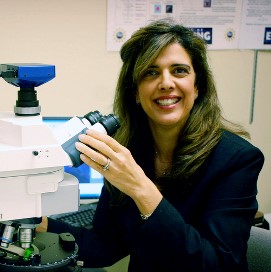Meet the Editors: Q&A with Professor Chrysanthe Preza, Executive Editor for Biological Imaging

Next in our series introducing the Editorial Board for the new Open Access journal, Biological Imaging, we meet Professor Chrysanthe Preza. She is an Executive Editor for the journal, the principal investigator of the Computational Imaging Research Laboratory, and the Kanuri Professor and Chair of the Department of Electrical and Computer Engineering at the University of Memphis, USA.
Can you tell us a bit about your background and how you first became interested in biological imaging?
I’ve been interested in mathematics and science from an early young age, growing up in Cyprus. My father was an engineer, who supported and believed in me, which gave me the confidence to pursue my passions. I was lucky enough to be awarded a Fulbright scholarship, which gave me the opportunity to travel to the United States to study computer science and electrical engineering at Washington University in St Louis.
While there, I had the opportunity to work as a graduate research assistant at the Biomedical Computer Laboratory, where I was first exposed to computational imaging, and later in the Electronic Systems and Signals Research Laboratory, where I continued my research as a faculty member. This work sparked a lifelong enthusiasm for computational imaging.
What has been your greatest achievement in your career so far?
My biggest achievement so far is becoming the Kanuri Professor and Chair of the Department of Electrical and Computer Engineering at the University of Memphis, where I contribute as an educator and researcher, while serving as a role model to women in a male-dominated field. I joined the Department of Electrical and Computer Engineering in August 2006 and have been able to pursue my passions and work with some fantastic colleagues and talented students. I am particularly proud of all the students in my research lab who successfully completed their degrees under my supervision.
What is your current research focused on?
My current research focus is on different microscopy modalities, working to extract useful information by processing the acquired data with new computational approaches and often by altering how data is collected by making changes to the imaging instruments.
My lab works to design the instrument and the computations at the same time so that optimal imaging system performance can be achieved. Machine learning currently used in computational imaging shows promising results, but neural networks are still very much a “black box” and require large training data sets. I believe it is important to use imaging models developed over the years to guide neural networks and make them more interpretable. Physics-guided neural networks are better suited for computational imaging, and my current research is contributing to that effort.
Why did you decide to become an Executive Editor?
My research in computational imaging is interdisciplinary, involving mathematics, optics, computer science and biology.
I am passionate about Biological Imaging because it aligns so well with my research and provides a means for those of us who engage in interdisciplinary research to share our ideas and work. We all come from different disciplines and approach imaging problems from various perspectives – bringing diversity to the field of quantitative biological imaging research. I am really proud and honored to be a part of the Editorial Board!
How will Biological Imaging benefit your research field?
I believe in the proverb: “If you want to go fast, go alone; but if you want to go far, go together.” Collaborations help to drive research and ensure that the technology developed in my lab is actually used by others. Biological Imaging will help to create different collaborations and share diverse ideas.
Diversity is an essential component of a successful project; when various backgrounds, fields and ideas are represented, there is an opportunity to find better, more creative solutions.
How do authors benefit from Biological Imaging being open access?
Biological Imaging provides a fantastic opportunity for everyone working in this field to make a contribution to the latest research.
Biological Imaging is a single open access forum for important bioimaging research. It publishes original reports, reviews and other article types on techniques and methods that use imaging approaches including: microscopy, image acquisition and processing, data mining and analysis, mathematical modelling and machine learning. Submit your papers here and follow the journal on Twitter, @blg_journal.






